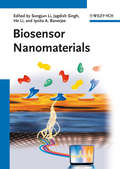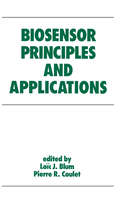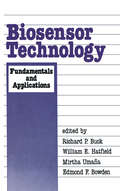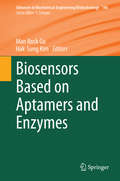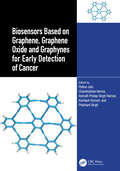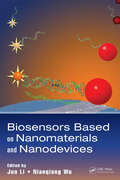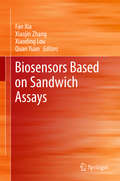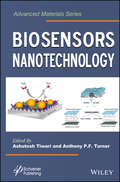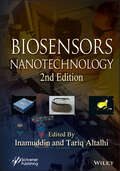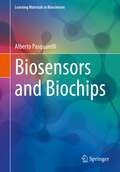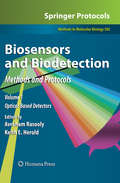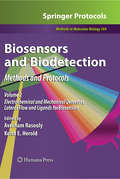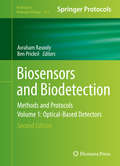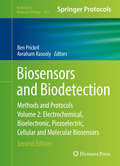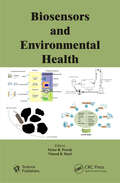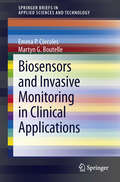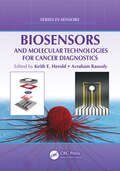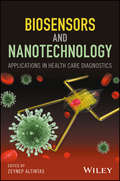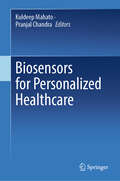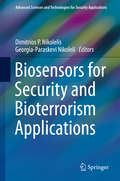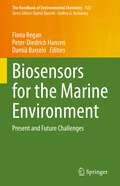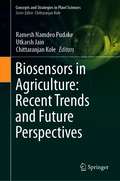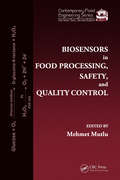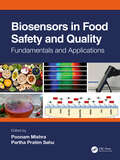- Table View
- List View
Biosensor Nanomaterials
by Songjun Li Jagdish Singh He Li Ipsita A. BanerjeeBiosensors are devices that detect the presence of microbials such as bacteria, viruses or a range biomolecules, including proteins, enzymes, DNA and RNA. For example, they are routinely applied for monitoring the glucose concentration in blood, quality analysis of fresh and waste water and for food control. Nanomaterials are ideal candidates for building sensor devces: where in just a few molecules can alter the properties so drastically that these changes may be easily detected by optical, electrical or chemical means. Recent advantages have radically increased the sensitivity of nanomaterial-based biosensors, making it possible to detect one particular molecule against a background of billions of others. Focusing on the materials suitable for biosensor applications, such as nanoparticles, quantum dots, meso- and nanoporous materials and nanotbues, this text enables the reader to prepare the respective nanomaterials for use in actual devices by appropriate functionalization, surface processing or directed self-assembly. The emphasis throughout is on electrochemical, optical and mechancial detection methods, leading to solutions for today's most challenging tasks. The result is a reference for researchers and developers, disseminating first-hand information on which nanomaterial is best suited to a particular application - and why.
Biosensor Principles and Applications (Biotechnology And Bioprocessing Ser.)
by Pierre R. Coulet Loïc J. BlumConsiders a new generation of sensors for use in industrial processes, which measure the chemical environment directly by means of a biological agent mainly enzymes so far. Various specialists from Europe, the US, and Japan identify the device's place in their disciplines; review the principles of m
Biosensor Technology: Fundamentals and Applications
by BuckThis authoritative reference covers recent advances in the field, stressing an interdisciplinaryapproach to the development and use of biosensor technology in physics,engineering, analytical chemistry, and biochemistry (including immunochemistry).about the editors ...RICHARD P. BucK is a Professor in the Chemistry Department, University of Northcarolina, Chapel Hill. Professor Buck serves on the editorial boards of severaljournals including Analytical Instrumentation: Applications and Designs for Chemica~Biomedica~ and Environmental Science (Marcel Dekker, Inc.). He is a member of theAmerican Chemical Society, Electrochemical Society, and International Society ofElectrochemistry. He received the B.S. (1950) and M.S. (1951) degrees from thecalifornia Institute of Tochnology, Pasadena, and Ph.D. degree (1954) from theMassachusetts Institute of Tochnology, cambridge.W1WAM E. HATFIELD is Mary Ann Smith Professor and Vice Chairman of Chemistry,and Acting Chairman of the Curriculum in Applied Sciences, University of Northcarolina, Chapel Hill. He is the author or coauthor of over 300 publications, andcoeditor, with John H. Miller, Jr., of High-Temperature Superconducting Materials:Preparations, Properties, and Processing (Marcel Dekker, Inc.). He is a member of theAmerican Chemical Society, American Association for the Advancement of Science,and Materials Research Society. He received the B.S. (1958) and M.S. (1959) degreesfrom Marshall University, Huntington, West Virginia, Ph.D. degree (1962) from theUniversity of Arizona, Tucson, and completed postdoctoral research at the Universityof Illinois, Urbana.M1KTHA UMANA is an independent consultant to Glaxo Inc. and Research 'IriangleInstitute, Research 'Iriangle Park, and Duke University Engineering Research Center,Durham, North carolina. The coauthor of numerous scientific journal articles, herresearch interests include surface chemistry, electrochemistry, and biosensors. Shereceived the B.Sc. degree (1969) from the University of Chile, Santiago, and Ph.D.degree (1972) from the University of London, England.EDMOND E BowoEN is an Associate Professor in the Department of Chemistry andin the Biotechnology Program, North carolina State University, Raleigh. Thecoauthor of numerous journal articles, his research interests include bioelectrochemistry,biological electron transfer, biosensors, and surface chemistry. He receivedthe B.S. degree (1970) from Syracuse University, Syracuse, New York, and Ph.D.degree (1982) from Virginia Commonwealth University, Richmond.
Biosensors Based on Aptamers and Enzymes (Advances in Biochemical Engineering/Biotechnology #140)
by Man Bock Gu Hak-Sung KimVolumes are organized topically and provide a comprehensive discussion of developments in the respective field over the past 3-5 years. The series also discusses new discoveries and applications. Special volumes are dedicated to selected topics which focus on new biotechnological products and new processes for their synthesis and purification. In general, special volumes are edited by well-known guest editors. The series editor and publisher will however always be pleased to receive suggestions and supplementary information. Manuscripts are accepted in English.
Biosensors Based on Graphene, Graphene Oxide and Graphynes for Early Detection of Cancer
by Chandrabhan Verma Pallavi Jain Prashant Singh Anirudh Pratap Singh Raman Kamlesh KumariThe detection of cancer at its earliest stages is paramount for successful treatment and improved patient outcomes. In recent years, the field of nanotechnology has witnessed significant advancements, and one material that has emerged as a potential game-changer in cancer detection is graphene. Graphene's high surface area, excellent electrical conductivity, and ability to interact with biological molecules have paved the way for innovative approaches to diagnosing cancer. Moreover, graphene oxide, a derivative of graphene, has gained significant attention in the field of cancer detection. Its unique properties, including biocompatibility and high photothermal conversion efficiency, enable its use in various imaging techniques. Graphene oxide can selectively accumulate in tumor tissues, enhancing the contrast signals in imaging modalities like optical imaging, magnetic resonance imaging (MRI), and photoacoustic imaging. This allows for precise visualization and localization of cancerous cells or tissues, aiding in early detection and accurate diagnosis.Features: Provides a comprehensive exploration of carbon, its allotropes, and its significance in emerging applications. Discusses the synthesis and functionalization of graphene on diverse substrates, and modeling approaches employed in graphene research. Details the application of graphene, graphene oxide, and graphyne-based materials on cancer detection. Explores the overview of the wider biological applications of carbon-based materials. This book will serve as a valuable reference source for researchers, academics, and biologists working in R&D and interested in biosensing for the early detection of cancer.
Biosensors Based on Nanomaterials and Nanodevices (Nanomaterials and their Applications)
by AntonioBiosensors Based on Nanomaterials and Nanodevices links interdisciplinary research from leading experts to provide graduate students, academics, researchers, and industry professionals alike with a comprehensive source for key advancements and future trends in nanostructured biosensor development. It describes the concepts, principles, materials, device fabrications, functions, system integrations, and applications of various types of biosensors based on signal transduction mechanisms, including fluorescence, photonic crystal, surface-enhanced Raman scattering, electrochemistry, electro-luminescence, field-effect transistor, and magnetic effect. The book: Explains how to utilize the unique properties of nanomaterials to construct nanostructured biosensors to achieve enhanced performance Features examples of biosensors based on both typical and emerging nanomaterials, such as gold nanoparticles, quantum dots, graphene, graphene oxides, magnetic nanoparticles, carbon nanotubes, inorganic nanowires/nanorods, plasmonic nanostructures, and photonic crystals Demonstrates the broad applications of nanostructured biosensors in environmental monitoring, food safety, industrial quality assurance, and in vitro and in vivo health diagnosis Inspires new ideas for tackling multiscale and multidisciplinary issues in developing high-performance biosensors for complex practical biomedical problems Focusing on the connection between nanomaterials research and biosensor development, Biosensors Based on Nanomaterials and Nanodevices illustrates the exciting possibilities and critical challenges of biosensors based on nanomaterials and nanodevices for future health monitoring, disease diagnosis, therapeutic treatments, and beyond.
Biosensors Based on Sandwich Assays
by Fan Xia Xiaojin Zhang Xiaoding Lou Quan YuanThis book shows the various sandwich assays that are constructed from recognition molecules, such as antibodies, oligonucleotide sequences and aptamers, developed as a result of nano- and biotechnology advances. It consists of ten chapters presenting interesting examples of these assays, organized according to the type of analytic methods (colorimetric, fluorescence, electrochemical, etc. ) and detected objects (protein, nucleic acid, small-molecule, ion, etc. ). It also includes a chapter discussing the introduction of sandwich assays as biosensors for the detection of a range of targets. It is an interesting and useful resource for a wide readership in various fields of chemical science and nanotechnology.
Biosensors Nanotechnology
by Ashutosh Tiwari Anthony P.F. TurnerA new emerging field that combines nanoscale materials and biosensor technology is receiving increased attention. Nanostructures have been used to achieve direct wiring of biosensing elements to electrode surfaces, to promote bio-reactions, to impose nanobarcodes on biomaterials, and to amplify the signal from bio-recognition events. Nanomaterials based biosensors have found wide spread applications in the environmental and medical applications for their sensitivity, specificity, rapidity, simplicity, and cost-effectiveness. In the same pursuit, Biosensors Nanotechnology provides detailed review chapters on a range of nanostructures such as nanoparticles, nanowires, nanotubes, nanoribbons, nanorods, nanobelts and nanosheets in the construction of biosensors with set applications of biosensors nanotechnology for biological and chemical analyses, food safety industry, biomedical diagnostics, clinical detection, and environmental monitoring. The senior contributors write on the following topics: ZnO and graphene microelectrode applications in biosensing Assembly of polymers/metal nanoparticles Gold nanoparticle-based electrochemical biosensors Impedimetric DNA sensing employing nanomaterials Graphene and carbon nanotube based biosensors The-state-of-art of nanomedicine Computational nanochemistry study BFPF green fluorescent protein chromophore Biosynthesis of metal nanoparticles Ionic discotic liquid crystals Role of advanced materials as nanosensors in water treatment Bioconjugated-nanoporous gold films in electrochemical biosensors Combination of molecular imprinting and nanotechnology Recent development of fiber reinforced composite materials Principal and properties of multiferroics and ceramics
Biosensors Nanotechnology
by Inamuddin Tariq AltalhiBIOSENSORS NANOTECHNOLOGY The second edition of Biosensors Nanotechnology comprises 20 chapters and discusses a wide range of applications exploited by biosensors based on nanoparticles including new domains of bionics, power production and computing. The biosensor industry began as a small, niche activity in the 1980s and has since developed into a large, global industry. Nanomaterials have substantially improved not only non-pharmaceutical and healthcare uses, but also telecommunications, paper, and textile manufacturing. Biological sensing assists in the understanding of living systems and is used in a variety of sectors, including medicine, drug discovery, process control, environmental monitoring, food safety, military and personal protection. It allows for new opportunities in bionics, power generation and computing, all of which will benefit from a greater understanding of the bio-electronic relationship, as advances in communications and computational modeling enable us to reconsider how healthcare is offered and R&D and manufacturing are enhanced. In this fast-evolving discipline, the combination of nanoscale materials with biosensor technology has gained a lot of traction. Nanostructures have been used to increase the adherence of biosensor materials to electrode surfaces, print nano barcodes on biomaterials, increase the pace of bio-responses, and amplify the electric signal. Some of the topics discussed in the book include: Bioreceptors for Cells; Bioreceptors for Enzymatic Interactions; Dendrimer-Based Nanomaterials for Biosensors; Biosensors in 2D Photonic Crystals; Bioreceptors for Affinity Binding in Theranostic Development; Biosensors for Glucose Monitoring; Metal-Free Quantum Dots-Based Nanomaterials for Biosensors; Bioreceptors for Microbial Biosensors; Plasmonic Nanomaterials in Sensors; Magnetic Biosensors; Biosensors for Salivary Biomarker Detection of Cancer and Neurodegenerative Diseases; Design and Development of Fluorescent Chemosensors for the Recognition of Biological Amines and Their Cell Imaging Studies; Application of Optical Nanoprobes for Supramolecular Biosensing; In Vivo Applications for Nanomaterials in Biosensors; Biosensor and Nanotechnology for Diagnosis of Breast Cancer; Bioreceptors for Antigen–Antibody Interactions; Biosensors for Paint and Pigment Analysis; Bioreceptors for Tissue; Biosensors for Pesticide Detection; and Advances in Biosensor Applications for Agroproducts Safety. Audience The book is written for a large and broad readership including researchers, industry engineers, and university graduate students from diverse backgrounds such as chemistry, materials science, physics, pharmacy, medical science, biomedical engineering, electronics engineering, and nanotechnology.
Biosensors and Biochips (Learning Materials in Biosciences)
by Alberto PasquarelliThis textbook describes the basic principles and mechanism of action of biosensor systems, and introduces readers to the various types of biosensors; from affinity biosensors to catalytic, optical and label-free biosensors, the most common systems are explained in detail. Dedicated advanced sections focus on biochips and genome sequencing methods as well as organs-on-a-chip. The textbook helps readers to understand the elementary components of biosensors, and to identify and illustrate each function in the biosensor information flow, from recognition to transduction and transmission. Furthermore, readers will receive guidance in critically analyzing published studies on biosensor research, helping them to develop appropriate concepts and independently propose their own solutions. The textbook is intended for master’s students in bioengineering, biophysics, biotechnology and pharmacology that need a solid grasp of biosensor system technologies and applications, as well as students in related medical technological fields.
Biosensors and Biodetection - Methods and Protocols Volume 1: Methods and Protocols Volume 1: Optical-Based Detectors (Methods in Molecular Biology #503)
by Keith Herold Avraham RasoolyBiosensors combine biological recognition elements and signal conversion elements into a biodetection system. They have been developed for a wide variety of biodetection applications, offering the advantages of increased speed and ease of use compared to traditional detection methods. In Biosensors and Biodetection: Methods and Protocols, leading experts describe the major technologies in the field in extensive technical detail, allowing readers both to understand the technology and to construct similar devices. Volume 1: Optical-Based Detectors delves into direct and indirect optical detectors, including methods involving surface plasmon resonance, interferometric sensors, CCD based detectors, and spectrometers, among many other cutting-edge technologies. Written in the highly successful Methods in Molecular BiologyTM series format, chapters include brief introductions to the subjects, lists of the necessary materials, step-by-step, readily reproducible protocols, and Notes sections, which highlight tips on troubleshooting and avoiding known pitfalls.<P><P> Comprehensive and up-to-date, Biosensors and Biodetection: Methods and Protocols is an ideal, user-friendly guide to this vital, versatile technology and a perfect tool for those who wish to further the field.
Biosensors and Biodetection - Methods and Protocols Volume 2: Methods and Protocols Volume 2: Electrochemical and Mechanical Detectors, Lateral Flow and Ligands for Biosensors (Methods in Molecular Biology #504)
by Keith Herold Avraham RasoolyBiosensors combine biological recognition elements and signal conversion elements into a biodetection system. They have been developed for a wide variety of biodetection applications, offering the advantages of increased speed and ease of use compared to traditional detection methods. In Biosensors and Biodetection: Methods and Protocols, leading experts describe the major technologies in the field in extensive technical detail, allowing readers both to understand the technology and to construct similar devices. Volume 2: Electrochemical and Mechanical Detectors, Lateral Flow and Ligands for Biosensors focuses on direct measurement sensors, indirect methods, ligands, and related technologies, including methods involving electrochemical detectors, recognition ligands, antibodies, aptamers, and peptides, amongst many other subjects. Written in the highly successful Methods in Molecular Biology™ series format, chapters include brief introductions to the topics, lists of the necessary materials, step-by-step, readily reproducible protocols, and Notes sections, which highlight tips on troubleshooting and avoiding known pitfalls.<P><P> Comprehensive and up-to-date, Biosensors and Biodetection: Methods and Protocols is an ideal, user-friendly guide to this vital, versatile technology and a perfect tool for those who wish to further the field.
Biosensors and Biodetection: Methods and Protocols Volume 1: Optical-Based Detectors (Methods in Molecular Biology #1571)
by Avraham Rasooly Ben PrickrilThis volume provides comprehensive and detailed technical protocols on current biosensor and biodetection technologies and examples of their applications and capabilities. Chapters in Biosensors and Biodetection: Methods and Protocols, Volume 1: Optical-Based Detectors, Second Edition chapters focus on direct and indirect optical detectors including surface plasmon resonance, interferometric sensors, charge-coupled device (CCD) based detectors, spectrometry, and many other cutting-edge optical biosensors technologies. Written in the format of the highly successful Methods in Molecular Biology series, chapters include introductions to their respective topics, lists of the necessary materials and reagents, tips on troubleshooting and avoiding known pitfalls, and step-by-step, readily reproducible laboratory protocols. Authoritative and practical, Biosensors and Biodetection: Methods and Protocols, Volume 1: Optical-Based Detectors, Second Edition offers descriptions of major technologies by leading experts in the field in extensive technical detail. The aim of the book is to make biosensors more accessible and understandable to engineers, students, medical professionals, molecular biologists, chemical, and physical science researchers developing biosensor technologies, allowing readers to both understand the technology and to construct similar devices.
Biosensors and Biodetection: Methods and Protocols, Volume 2: Electrochemical, Bioelectronic, Piezoelectric, Cellular and Molecular Biosensors (Methods in Molecular Biology #1572)
by Avraham Rasooly Ben PrickrilThis volume provides comprehensive and detailed technical protocols on current biosensor and biodetection technologies and examples of their applications and capabilities. Chapters in Biosensors and Biodetection: Methods and Protocols, Volume 1: Optical-Based Detectors, Second Edition chapters focus on direct and indirect optical detectors including surface plasmon resonance, interferometric sensors, charge-coupled device (CCD) based detectors, spectrometry, and many other cutting-edge optical biosensors technologies. Written in the format of the highly successful Methods in Molecular Biology series, chapters include introductions to their respective topics, lists of the necessary materials and reagents, tips on troubleshooting and avoiding known pitfalls, and step-by-step, readily reproducible laboratory protocols. Authoritative and practical, Biosensors and Biodetection: Methods and Protocols, Volume 1: Optical-Based Detectors, Second Edition offers descriptions of major technologies by leading experts in the field in extensive technical detail. The aim of the book is to make biosensors more accessible and understandable to engineers, students, medical professionals, molecular biologists, chemical, and physical science researchers developing biosensor technologies, allowing readers to both understand the technology and to construct similar devices.
Biosensors and Environmental Health
by Victor R. Preedy Vinood B. PatelDiscussing the role biosensors play in detecting and monitoring environmental substances, Biosensors and Environmental Health provides key facts that can be applied to other areas of health and disease and a "mini-dictionary" of key terms and summary points. It covers personal toxicity testing, soil and risk assessment, pesticide, insecticides, par
Biosensors and Invasive Monitoring in Clinical Applications (SpringerBriefs in Applied Sciences and Technology)
by Martyn G. Boutelle Emma P. CórcolesThis volume examines the advances of invasive monitoring by means of biosensors and microdialysis. Physical and physiological parameters are commonly monitored in clinical settings using invasive techniques due to their positive outcome in patients' diagnosis and treatment. Biochemical parameters, however, still rely on off-line measurements and require large pieces of equipment. Biosensing and sampling devices present excellent capabilities for their use in continuous monitoring of patients' biochemical parameters. However, certain issues remain to be solved in order to ensure a more widespread use of these techniques in today's medical practices.
Biosensors and Molecular Technologies for Cancer Diagnostics (Series in Sensors)
by Avraham Rasooly Keith E. HeroldBridging the gap between research and clinical application, Biosensors and Molecular Technologies for Cancer Diagnostics explores the use of biosensors as effective alternatives to the current standard methods in cancer diagnosis and detection. It describes the major aspects involved in detecting and diagnosing cancer as well as the basic elements
Biosensors and Nanotechnology: Applications in Health Care Diagnostics
by Zeynep AltintasProvides a broad range of information from basic principles to advanced applications of biosensors and nanomaterials in health care diagnostics This book utilizes a multidisciplinary approach to provide a wide range of information on biosensors and the impact of nanotechnology on the development of biosensors for health care. It offers a solid background on biosensors, recognition receptors, biomarkers, and disease diagnostics. An overview of biosensor-based health care applications is addressed. Nanomaterial applications in biosensors and diagnostics are included, covering the application of nanoparticles, magnetic nanomaterials, quantum dots, carbon nanotubes, graphene, and molecularly imprinted nanostructures. The topic of organ-specific health care systems utilizing biosensors is also incorporated to provide deep insight into the very recent advances in disease diagnostics. Biosensors and Nanotechnology: Applications in Health Care Diagnostics is comprised of 15 chapters that are presented in four sections and written by 33 researchers who are actively working in Germany, the United Kingdom, Italy, Turkey, Denmark, Finland, Romania, Malaysia and Brazil. It covers biomarkers in healthcare; microfluidics in medical diagnostics; SPR-based biosensor techniques; piezoelectric-based biosensor technologies; MEMS-based cell counting methods; lab-on-chip platforms; optical applications for cancer cases; and more. Discusses the latest technology and advances in the field of biosensors and their applications for healthcare diagnostics Particular focus on biosensors for cancer Summarizes research of the last 30 years, relating it to state-of-the-art technologies Biosensors and Nanotechnology: Applications in Health Care Diagnostics is an excellent book for researchers, scientists, regulators, consultants, and engineers in the field, as well as for graduate students studying the subject.
Biosensors for Personalized Healthcare
by Pranjal Chandra Kuldeep MahatoThis book covers the basic principles and advanced methods used in the advancement of bioelectronics for therapeutic purposes. This book provides a thorough examination of the development and progress in bioelectronics devices and biosensors, emphasizing current improvements in individualized diagnostics using biosensing modules, tools, and approaches. It offers useful insights into the creation of biosensors for individualized healthcare diagnostics by analyzing the underlying principles of sensing methods. This book primarily emphasizes the incorporation of biosensing technologies into wearable, implantable, and biomedical devices. These advancements are transforming healthcare by enabling uninterrupted monitoring and immediate data gathering, ultimately improving patient care. The book also highlights the significance of downsizing biosensor platforms, demonstrating approaches that enhance the compactness and efficiency of these devices while maintaining their performance. The book also discusses point-of-care devices, which are of great importance. These devices are essential in clinical laboratories and care units, such as ICUs and ambulatory settings, since they provide fast, precise, and immediate diagnostic capabilities. The book showcases the most recent breakthroughs in personalized diagnostics via the use of biosensing-based bioelectronics devices, highlighting its capacity to revolutionize the provision of healthcare. This book examines the real-world uses of biosensor technology in customized healthcare throughout various chapters. It explores the customization of these devices to cater to the specific requirements of each patient, enabling accurate and prompt medical treatments. This book is a valuable resource for academics, practitioners, and enthusiasts in the subject of bioelectronics and healthcare. It combines in-depth scientific discussions with practical real-world applications. In essence, this book serves as a foundation for comprehending the profound influence of biosensor technology on personalized health care. This book encourages readers to investigate the promising opportunities that await in the field of bioelectronics, where groundbreaking devices and methods are poised to revolutionize medical diagnostics and patient treatment.
Biosensors for Security and Bioterrorism Applications (Advanced Sciences and Technologies for Security Applications)
by Dimitrios P. Nikolelis Georgia-Paraskevi NikoleliThis book offers comprehensive coverage of biomarker/biosensor interactions for the rapid detection of weapons of bioterrorism, as well as current research trends and future developments and applications. It will be useful to researchers in this field who are interested in new developments in the early detection of such. The authors have collected very valuable and, in some aspects indispensable experience in the area i. e. in the development and application of portable biosensors for the detection of potential hazards. Most efforts are centered on the development of immunochemical assays including flow-lateral systems and engineered antibodies and their fragments. In addition, new approaches to the detection of enzyme inhibitors, direct enzymatic and microbial detection of metabolites and nutrients are elaborated. Some realized prototypes and concept devices applicable for the further use as a basis for the cooperation programs are also discussed. There is a particular focus on electrochemical and optical detection systems, including those employing carbon nanotubes, quantum dots and metal nanoparticles. The authors are well-known scientists and most of them are editors of respected international scientific journals. Although recently developed biosensors utilize known principles, the biosensing devices described can significantly shorten the time required for successful detection and enhance efforts in more time-consuming directions, e. g. remote sensing systems and validation in real-sample analysis. The authors describe advances in all stages of biosensor development: the selection of biochemical components, their use in biosensor assembly, detection principles and improvements and applications for real sample assays.
Biosensors for the Marine Environment: Present and Future Challenges (The Handbook of Environmental Chemistry #122)
by Damià Barceló Fiona Regan Peter-Diedrich HansenThis book is devoted to the exploration of innovative sensing technologies for marine applications. The book focuses on various novel biosensor designs from nano-biosensors to molecularly imprinted polymers offering a broad perspective for marine biosensors development to deployment challenges.The book aims to target researchers in the area of marine monitoring, sensor developments and deployment of devices in the marine environment.
Biosensors in Agriculture: Recent Trends and Future Perspectives (Concepts and Strategies in Plant Sciences)
by Chittaranjan Kole Ramesh Namdeo Pudake Utkarsh JainThis book reviews the application of nanosensors in food and agriculture. Nanotechnology has the potential to become transformative technology that will impact almost all sectors. Tools like nanosensors, which detect specific molecular interactions, can be used for on-site, in-situ and online measurements of various parameters in clinical diagnostics, environmental and food monitoring, and quality control.Due to their unprecedented performance and sensitivity, nanobiosensors are gaining importance in precision farming. The book examines the use of nanobiosensors in the monitoring of food additives, toxins and mycotoxins, microbial contamination, food allergens, nutritional constituents, pesticides, environmental parameters, plant diseases and genetically modified organisms. It also discusses the role of biosensors in increasing crop productivity in sustainable agriculture, and nanosensor-based smart delivery systems to optimize the use of natural resources such as water, nutrients and agrochemicals in precision farming.
Biosensors in Food Processing, Safety, and Quality Control (Contemporary Food Engineering)
by Mehmet MutluThis book details the latest developments in sensing technology and its applications in the food industry, profiling the improvements achieved in recent years for better food quality, safety, processing, and control. Topics discussed include the use of biosensors for the assessment of natural toxins in food and for pesticides and foodborne pathogen
Biosensors in Food Safety and Quality: Fundamentals and Applications
by Partha Pratim Sahu Poonam MishraBiosensors in food safety and quality have become indispensable in today’s world due to the requirement of food safety and security for human health and nutrition. This book covers various types of sensors and biosensors that can be used for food safety and food quality monitoring, but these are not limited to conventional sensors, such as temperature sensors, optical sensors, electrochemical sensors, calorimetric sensors, and pH sensors. The chapters are framed in a way that readers can experience the novel fabrication procedures of some advanced sensors, including lab-on-a-chip biosensors, IoT-based sensors, microcontroller-based sensors, and so on, particularly for fruits and vegetables, fermented products, plantation products, dairy-based products, heavy metal analysis in water, meat, fish, etc. Its simplistic presentation and pedagogical writing provide the necessary thrust and adequate information for beginners, scientists, and researchers. The book offers comprehensive coverage of the most essential topics, which include the following: Fundamentals of biosensors Overview of food safety and quality analysis Major toxicants of food and water Fabrication techniques of biosensors applicable for different segments of the food industry This book serves as a reference for scientific investigators who work on the assurance of food safety and security using biosensing principles as well as researchers developing biosensors for food analysis. It may also be used as a textbook for graduate-level courses in bioelectronics.
Biosensors: An Introductory Textbook
by Jagriti Narang C. S. PundirNanotechnology is a budding field and has a pivotal role in sensing. Nanomaterials exist in various forms such as nanoparticles, nanoclusters, nanobelts, and nanospheres. These nanomaterials act as sensing interfaces and immobilization surfaces for various biomolecules such as enzymes, DNA, and antigens. Therefore, the preparation and characterization of these nanoparticles play an important role in sensing devices. This handbook has evolved from the authors’ teaching and research experience in the field of nanoparticle biosensing. It encompasses protocols for the synthesis of various forms of metal oxide nanoparticles; study of the various characterizing techniques that help deduce the shape, size, and morphology of these nanoparticles; and applications of these nanoparticles in the field of biosensors. It presents voltammetry techniques such as cyclic, linear wave, wave pulse, and differential pulse voltammetry, throws light on the interactions of nanomaterials and biomolecules, and discusses microfluidic devices, which due to their unique capability of miniaturization fascinate many researchers. It is a practical and user-friendly textbook that introduces the various basic principles and practical information that will help undergraduate and advanced-level students and researchers understand the science behind nanoscale sensing.
